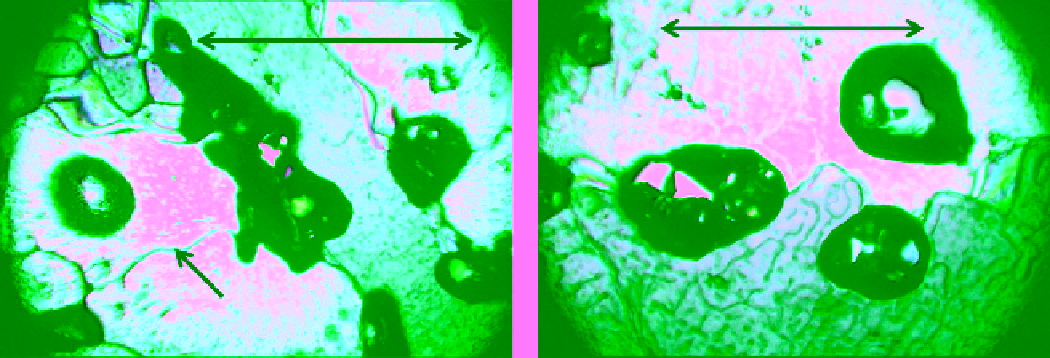Geology Reference
In-Depth Information
1 mm
1 mm
Sub-grain boundary
Figure 4.41
Optical micrographs, taken with polarized light, showing bubbles at a depth of 0.14 m in MY
hummock ice in Resolute Passage, Nunavut, Canada, in May 1992; subgrain boundary is revealed by thermal
etching [
Shokr and Sinha,
1994].
4.4.3.2. Melt Pond Ice
As with hummock ice, melt pond ice exhibits a variety
of microstructure patterns. Unlike hummock ice, how-
ever, two distinct types of air inclusions exist in MP ice.
The first takes the form of clusters of bubbles. This is
believed to originate from air entrapped between snow
grains. Large clusters were consistently found in snow‐ice
layers forming at the top layer of MP ice. This layer is
formed during freezing of snow slush or of waterlogged
snow deposited on a pond. The second is small air bub-
bles trapped in the water or rejected during formation of
ice in the pond. Both types differ from air bubbles in
hummock ice in terms of formation mechanism and geo-
metrical characteristics.
Figure 4.42 shows a vertical section of the upper 140 mm
depth and a horizontal section at 90 mm depth of polycrys-
talline structure of MP ice in the central Arctic. The verti-
cal section exhibits three layers of distinct structure. The
top layer, about 35 mm in thickness, is comprised of numer-
ous small ice crystals about 1 mm in diameter, which are
isotropic and equiaxed. This is granular ice, which was
developed from freezing of water saturated with snow. Air
entrapped between snow particles evolves into nearly
spherical inclusions, depicted as large bright objects in
Figure 4.42b. Their average diameter is 4 mm. These inclu-
sions are consistently observed in, and confined only to,
the subsurface layer of MP ice. Compared to commonly
observed bubbles in hummock ice, they are more isotropic
in shape and well separated. The middle layer, 25 mm thick,
comprises ice crystals formed during the selection process,
when columnar‐grained structure developed and crystals
with their basal planes parallel to the growth direction or
the direction of maximum heat flow continued to grow.
Smaller air bubbles, ranging from a fraction of a millimeter
to slightly above 1 mm, are readily visible in this layer
(Figure 4.42b). They are most probably formed from dis-
solved air in the pond water, which is rejected during solidi-
fication. This type of bubble was found consistently in melt
pond ice, mostly around small ice crystals. The third layer,
about 100 mm below the surface, exhibits clear, nearly
inclusion‐free columnar crystals. The nonplaner or slightly
irregular boundaries of the grains (Figure 4.42c) suggests
that the ice grew from brackish water. Measured salinity at
this layer ranges between 1.1‰ and 1.4‰. The three layers
contain newer ice and therefore appear to be formed sub-
sequent to a melt season.
Figure 4.43 shows a vertical section from 150 to 270 mm
depth from another MP ice core. The core consisted of a
230 mm layer of nonsaline granular, snow ice with grain
diameters less than 2 mm. This suggested that ice was
formed from water‐saturated snow cover when numerous
snow particles had existed as seeds. The top layer in the
figure shows air inclusions of the type observed in snow
ice. Their diameters range from 1.5 to 6 mm. Small air
bubbles, typically less than 1 mm in diameter, can also be
seen. Careful examination of each individual air bubble
of the large diameter in Figure 4.43a shows that its over-
all dark appearance is, in fact, cloudy with fading colors.
The colors denote the presence of fine crystals within the
inclusion. This supports the premise that the inclusions
were originated from larger air pockets entrapped
between snow particles during the freezing process.
The snow ice layer is underlain by a 30 mm transition
layer of larger grains whose length varies between 1 and
4 mm. The layer marks a transition between the fine
snow crystals at the top and the columnar grains that
represent the original brackish ice, which has been
retextured by aging. The development of columnar‐
grained ice also establishes the culmination of the selec-
tion process that leads to the survival of crystals with

